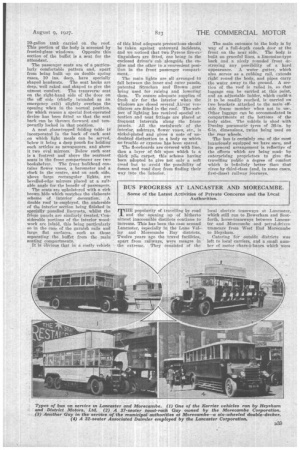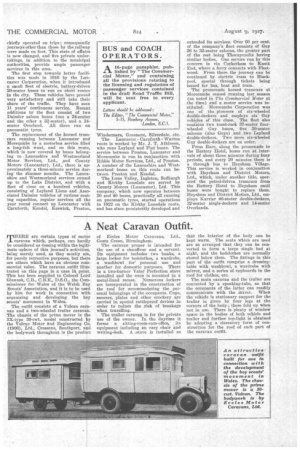BUS PROGRESS AT LANCASTER AND MORECAMBE.
Page 57

Page 58

If you've noticed an error in this article please click here to report it so we can fix it.
Some of the Latest Activities of Private Concerns and the Local Authorities.
MITE popularity of travelling by road J. and the opening up of hitherto almost inaccessible districts continue to increase. This has been the case around Lancaster, especially in the Lune Val-Icy and Morecambe Bay districts. Twelve years ago the travel facilities, apart from railways, were meagre in the extreme. They consisted of the local electric tramways at Lancaster, which still run to Bowerham and Scotforth, horse-tramways between Lancaster and Morecambe and petrol-driven tramcars from 'West End Morecambe to lleysham. .
Catering 'for outside districts was left to Ideal' carriers, and a small number of motor chars-a.-bancs Which were chiefly operated on trips; consequently journeys other than those by the railway were made on foot. This state of affairs is now changed, and five private undertakings, in addition to the municipal authorities, provide ample passenger services in this area.
The first step towards better facilities was made in 1916 by the Lancaster Corporation, when it introduced a small fleet of electric, battery-driven 20-seater buses to run on short.routes in the city. These vehicles have proved very satisfactory and still take their share of the traffic. They have seen 11 years' continuous service. Recent additions to the fleet consist of two Daimler saloon buses (one a 24-seater and the other a 32-seater), and a 14seater Overland. 'All three run on pneumatic tyres.
The replacement of the horsed tramcars running between Lancaster and Morecambe by a motorbus service filled a long-felt want, and on this route, which is now covered by buses belonging to Lancashire an Westmorland Motor Services, Ltd., _and County Motors (Lancaster), Ltd., there is approximately a three-minute service during' the slimmer months. The Lanceehire and Westmorland services extend up to the Lake District, and with a fleet of close on a hundred vehicles, consisting of Leyland Lions and Associated Daimler vehicles of various seating capacities, regular services all the year round connect up Lancaster with Carnforth, Kendal, Keswick, Preston, Windermere, Grasmere, Silverdale, etc.
The Lancaster CareforthWarton route is worked by Mr. J. T. Atkinson, who runs Leyland and Fiat buses. The service 'between Preston, Lancaster and Morecambe is run in conjunction with Ribble Motor Services, Ltd., of Preston. A number of the Lancashire and Westmorland buses on this route run between Preston and Kendal.
The Lune Valley, Ingleton, Sedburgh and Kirkby Lonsdale are served by County Motors (Lancaster), Ltd. This company, which now operates between 30 and 40 buses, practically all running on pneumatic tyres, started operations in 1922 on the Kirkby Lonsdale route, and has since persistently developed and ' extended its services. Over GO per cent. of the company's fleet consists of Guy .20 to 32-seater saloous, the greater part of the rest being Thornyerofts having similar bodies. One service run by this concern is via Coekerham to Knott End, where a ferry connects with Fleetwood. From there the journey can be continued by electric tram to Blackpool, special through tickets being issued for bus, boat and tram.. .
The' promenade horsed tramcars at Morecambe ceased running last season (as noted in The Cominereica Motor at the time) and a motor service was instituted. Morecambe Corporation was one of the pioneers of six-wheeled double-deckers and employs six Guy vehicles of this class. The fleet also contains two toast-rack 37-seater four, wheeled Guy buses, five 30-seater saloons (also Guys) and two Leyland double-deckers. Two more six-wheeled Guy double-deckers are on order.
From Bare, along the promenade to the Battery Hotel, buses run at intervals of about three minutes during busy periods, and every 20 minutes there is a through bus to Heysham Village. This service is worked in conjunction with Heysham and District Motors, Ltd., which, under another title, operated the petrol-driven tramcars from the Battery Hotel to Heysham until buses were bought to replace them. Heysham and District Motors, Ltd., employs Karrier 46-seater double-deckers, 32-seater single-deckers and 14-seater Overlands.




































































































